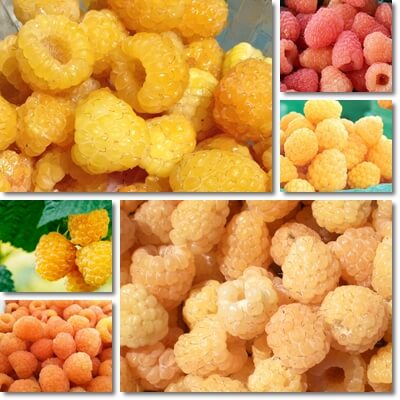Yellow raspberries have a mellow sweet taste and low acidity and are an extremely healthy food to eat. But what exactly makes yellow raspberries yellow? Where does the yellow color come from? How did yellow raspberries come to be? Are yellow raspberries genetically modified? Is the color of yellow raspberries natural? Where do yellow raspberries come from?
What are yellow raspberries?
Yellow raspberries are a yellow color variant of the raspberry fruit. They are basically raspberries that are yellow in color instead of red.
They both occur naturally in the wild and are present in cultivation, their bright and novel color drawing great commercial interest. There are currently multiple varieties of yellow raspberry being cultivated, with fruit differing slightly in color, size and taste.

Are yellow raspberries genetically modified?
Novelty colors in foods are often thought to the exclusive result of genetic modification. This is true for some foods such as yellow rice which was developed via genetic engineering with the clear purpose of creating a staple food that would naturally synthesize the pro-vitamin A pigment beta-carotene.
Yellow rice, also called golden rice, was intended to replace regular rice as a staple crop in areas with prevalent poverty and serve as an accessible and inexpensive solution for improving nutritional status in populations at high risk for vitamin A deficiency and associated side effects such as irreversible blindness and intellectual disability in children and increased susceptibility to infection and disease causing higher mortality rates.
But yellow raspberries are not genetically modified. In fact, yellow raspberries have occurred naturally to begin with, as evidenced by the existence of the yellow Himalayan raspberry or the golden Himalayan raspberry species Rubus ellipticus native to most of Asia. The yellow raspberry species occurs naturally in the wild without any form of human intervention.
Where do yellow raspberries come from?
There are three theories as to the origin of yellow raspberries. One: the yellow raspberry comes from the wild yellow raspberry species Rubus ellipticus, commonly known as the Himalayan yellow raspberry and Himalayan golden raspberry. According to this theory, the yellow raspberry is believed to have evolved naturally in the wild, as an independent species, occurring concurrently with the red raspberry.
Two: the yellow raspberry comes from the more common red raspberry, having evolved as a natural mutation that saw the dominant gene for the color red become dormant which caused a discoloration in the resulting fruit and the color yellow instead of red.
In this case, the parent species is Rubus idaeus, the common red raspberry or the European red raspberry. However, some voices credit the species Rubus strigosus, or the American red raspberry, as the parent of the yellow raspberry. Needless to say, both are very closely related, with the American red raspberry likely being a subspecies of the common red raspberry from Europe.
Three: the yellow raspberry evolved from purple or black raspberries as a result of a natural mutation that blocked the production of dark anthocyanin pigments in the fruit. This caused a discoloration in the resulting fruit producing what could be considered to be an albino fruit – the yellow raspberry.

Why are yellow raspberries yellow?
What makes yellow raspberries yellow instead of red, purple or black is a high content of natural yellow pigments paired with a low content of natural orange and red pigments and a very reduced content of dark red and purple pigments, if any.
Studies show varieties of yellow raspberry owe their color to a high content of xanthophylls, a class of primarily yellow carotenoid pigments. The xanthophylls zeaxanthin and lutein are predominant in yellow raspberries, but neoxanthin, violaxanthin, neochrome have also been identified.
For the yellow pigments to show through and color the fruit accordingly, there’s also a low content of orange, red and purple pigments. As a result, yellow raspberries are very low in beta-carotene, alpha-carotene as well as anthocyanin pigments (source). Yellow raspberries are also low in chlorophyll, but have considerable amounts of free lutein, esterified lutein and tocopherols (source).
The xanthophylls lutein and zeaxanthin in yellow raspberries are also the dominant pigments in yellow fleshed watermelon, egg yolk, yellow tomatoes, yellow bell peppers and yellow carrots.
What do yellow raspberries look like?
Different varieties of yellow raspberry exist and not all have the exact same yellow color. There are three major color variants for yellow raspberries:
- Yellow raspberries with pale yellow fruit
- Yellow raspberries with golden yellow fruit
- Yellow raspberries with gold fruit blushed generously with peach or entirely peach colored fruit, often referred to as gold or golden raspberries rather than yellow. Fruits may also have a more intense orangey-pink color.
Fruits may be smaller or larger, more rounded or slightly elongated towards the base. Both cultivar and growing conditions impact fruit size and appearance, especially color.
Also discover what are the benefits of eating yellow raspberries.
If the leaves on your yellow raspberry plant are yellowish, then your plant might be suffering from an iron deficiency. Consider an appropriate fertilizer to supply the plant with the needed nutrition.
What do yellow raspberries taste like?
Versus red raspberries which have a defining tart taste that dominates the flavor profile, yellow raspberries taste noticeably different. The taste of yellow raspberries is overtly sweet, with no perceivable acidity.
The lack of acidity amplifies the sweetness and rounds up the mellow fruity flavors of the fruit, contributing greatly to its popularity.
Are yellow raspberries rare?
Given the marked consumer interest in yellow raspberries and the growing preference for raspberries that are more sweet and less acidic, like the yellow variety, there has been a growing interest in cultivating yellow raspberries.
In addition to being cultivated commercially, yellow raspberries are also commonly cultivated in home settings, becoming less rare and more readily available with time.
